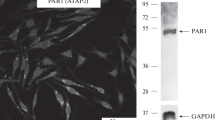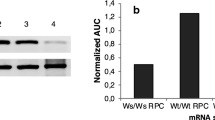Abstract
Human growth releasing factor (GRF) (1–29)NH2 releases histamine from pleural and peritoneal rat mast cells by a non cytotoxic and non immunological mechanism. Pretreatment of cells with pertussis toxin markedly inhibits the secretion, suggesting a possible function of a Gi-protein in the activation pathway. In order to determine the role of cAMP on GRF mediated secretion, mast cells were preincubated with isobutylmethylxanthine (IBMX) or cholera toxin, since both drugs greatly and enhance cAMP levels. IBMX inhibits mediator secretion while, in contrast, cholera toxin is ineffective to modify histamine release. The PKC activator TPA amplifies the response of mast cells to human GRF, shifting the dose-response curve to the left. The pretreatment of mast cells with the phosphatase inhibitor okadaic acid exerts no effect on the doseresponse function curve to GRF. The response to human GRF does not depend on extracellular calcium, but there is a good correlation between the percent of histamine released and45calcium uptake. The kinetic of calcium uptake is fast, maximum uptake being reached in 30 seconds.
Similar content being viewed by others
Abbreviations
- GRF:
-
(growth releasing factor)
- PTX:
-
(pertussis toxin)
- CTX:
-
(cholera toxin)
- OA:
-
(okadaic acid)
- TPA:
-
(12-Otetradecanoyl-phorbol-13-acetate)
- IBMX:
-
(isobutyl-methylxanthine)
References
Martin TW, Lagunoff D, Ed. (1984). Mast Cell secretion. Cell Biology of the secretory process. Basel, Karger.
Estevez MD, Botana MA, Arnaez E, Vieytes MR, Botana, LM. Histamine release on rat pleural and peritoneal mast cells elicited by human GRF(1–29)NH2. Int Arch Allergy Immunol 1993;100:86–8.
Mousli M, Bueb JL, Bronner C, Rouot B, Landry Y. G-Protein Activation — A Receptor-Independent Mode of Action for Cationic Amphiphilic Neuropeptides and Venom Peptides. Trends Pharmacol Sci 1990;11:358–62.
Eleno N, Botana LM, Espinosa J. Veratridine elicits histamine release and promotes calcium uptake in mast cells. Biochem Pharmacol 1988;37:3523–5.
Shore PA. Fluorometric assay of histamine. Meth Enz 1971;XVII:842–5.
Alfonso A, Botana MA, Vieytes MR, Botana LM. Functional characterization of the Na+-H+ exchanger in rat mast cells: crosstalks between different kinase pathways. Eur J Pharmacol Mol Pharmacol 1994;267:289–96.
Morgan JE, O'Neil CE, Coy DH, Hocart SJ, Nekola MV. Antagonistic analogs of luteinizing hormone-releasing hormone are mast cell secretagogues. Int Archs Allergy Appl Immunol 1986;80:70–5.
Theoharides TC, Douglas WW. Somatostatin induces histamine secretion from rat peritoneal mast cells. Endocrinology 1978;102:1637–40.
Foreman JC, Jordan CC, Piotrowski W. Interaction of neurotensin with the substance P receptor mediating histamine release from rat mast cells and the flare in human skin. Br J Pharmacol 1982;77:531–9.
Higashijima T, Burnier J, Ross EM. Regulation of GI and Go by Mastoparan, Related Amphiphilic Peptides, and Hydrophobic Amines — Mechanism and Structural Determinants of Activity. J Biol Chem 1990;265:14176–86.
Carraway RE, Cochrane DE, Granier C, Kitabgi P, Leeman E, Singer EA. Parallel secretion of endogenous 5-hydroxytryptamine and histamine from mast cells stimulated by vasoactive peptides and compound 48/80. Br J Pharmacol 1984;81:227–9.
Piotrowski W, Foreman JC. On the actions of substance P, somatostatin, and vasoactive intestinal polypeptide on rat peritoneal mast cells and in human skin. Naunyn Schmiedebergs Arch Pharmacol 1985;331:364–8.
Bueb JL, Mousli M, Landry Y, Bronner C. A pertussis toxinsensitive G protein is required to induce histamine release from rat peritoneal mast cells by bradykinin. Agents Actions 1990;30:98–101.
Tsakalos ND, Theoharides TC, Kops SK, Askenase PW. Induction of mast cell secretion by parathormone. Biochem Pharmacol 1983;32:355–60.
Theoharides TC. Mast cells: the immune gate to the brain. Life Sci 1990;46:607–17.
Hafez MM, Costlow, ME. Prolactin binding and localization in rat mammary tumor mast cells. Cancer Res 1988;48:3765–71.
Saito H, Okajima F, Molski TF, Shaafi RI, Ui M, Ishizaka T. Effect of cholera toxin on histamine release from bone marrowderived mouse mast cells. Proc Natl Acad Sci USA 1988;85:2504–8.
Saeki K, Ikeda S, Nishibori M. Calcium requirement for the inhibition by theophylline of histamine release from mast cells. Life Sci 1983;32:2973–80.
Peachell PT, MacGlashan DWJ, Lichtenstein LM, Schleimer RP. Regulation of human basophil and lung mast cell function by cyclic adenosine monophosphate. J Immunol 1988;140:571–9.
Grosman N, Nielsen KA. The influence of tetradecanoylphorbol-acetate (TPA) on histamine release from isolated rat mast cells. Agents Actions 1988;24:40–8.
Chakravarty N, Kjeldsen B, Hansen M, Nielsen EH. The involvement of protein kinase C in exocytosis in mast cells. Exp Cell Res 1990;186:245–9.
Heiman AS, Crews, FT. Characterization of the effects of phorbol esters on rat mast cell secretion. J Immunol 1985;134:548–55.
Botana LM, Alfonso A, Botana MA, Vieytes MR, Louzao MC et al. Influence of protein kinase C, cAMP and phosphatase activity on histamine release produced by compound 48/80 and sodium fluoride on rat mast cells. Agents Actions 1992;37:1–7.
Warner JA, Yancey KB, MacGlashan DWJ. The effect of pertussis toxin on mediator release from human basophils. J Immunol 1987;139:161–5.
Saito H, Okajima F, Molski TF, Shaafi RI, Ui M, Ishizaka T. Effects of ADP-ribosylation of GTP-binding protein by pertussis toxin on immunoglobulin E-dependent and -independent histamine release from mast cells and basophils. J Immunol 1987;138:3927–34.
Nakamura T, Ui M. Simultaneous inhibitions of inositol phospholipid breakdown, arachidonic acid release, and histamine secretion in mast cells by islet-activating protein, pertussis toxin. A possible involvement of the toxin-specific substrate in the Ca2+-mobilizing receptor-mediated biosignaling system. J Biol Chem 1985;260:3584–93.
Ingebritsen TS, Cohen P. The protein phosphatases involved in cellular regulation 1. Classification and substrate specificities. Eur J Biochem 1983;132:255–61.
Cohen P, Holmes CF, Tsukitani Y. Okadaic acid: a new probe for the study of cellular regulation. Trends Biochem Sci 1990;15:98–102.
Diamant B. New insights into the mechanisms of histamine release from rat peritoneal mast cells. Chem Immunol 1990;49:142–72.
Anderson P, Rohlich P, Uvnas B. The influence of calcium on morphology and histamine content of isolated intact rat mast cell granules. Acta Physiol Scand 1979;105:350–8.
Author information
Authors and Affiliations
Rights and permissions
About this article
Cite this article
Estévez, M.D., Alfonso, A., Vieytes, M.R. et al. Study of the activation mechanism of human GRF(1-29)NH2 on rat mast cell histamine release. Inflamm Res 44, 87–91 (1995). https://doi.org/10.1007/BF01793219
Received:
Revised:
Accepted:
Issue Date:
DOI: https://doi.org/10.1007/BF01793219




